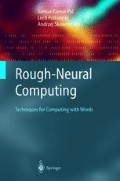Summary
Rough hybrid methods are used worldwide for pattern recognition and classification problems. In this chapter, WaRS, a combination of wavelets with rough set tools is presented, and examples of its application to problems of artificial and real-life (biomedical) origin are supplied.
Access this chapter
Tax calculation will be finalised at checkout
Purchases are for personal use only
Preview
Unable to display preview. Download preview PDF.
Reference
R. Agrawal, H. Manilla, R. Srikant, H. Toivonen, I. Verkamo. Fast discovery of association rules. InProceedings of the Conference on Advances in Knowledge Discovery and Data Mining307–328, AAAI-Press/MIT Press, Cambridge, MA, 1996.
J. Bazan. A comparison of dynamic and non-dynamic rough set methods for extracting laws from decision tables. In L.Polkowski, A. Skowron, editorsRough Sets in Knowledge Discovery 1321–365, Physica, Heidelberg, 1998.
J. Bazan.Approximate Reasoning Methods for Synthesis of Decision Algorithms.Ph. D. dissertation, Institute of Mathematics, Warsaw University, Warsaw 1998.
M. Beale, H.B. Demuth.Neural Network Toolbox.The MathWorks Inc., Natick, MA, 1997.
G. Beylkin, R. Coifman, V. Rokhlin Fast wavelet transforms and numerical algorithms I.Comm. Pure Appl. Math.43: 141–183, 1991.
L. Breiman, J.H. Friedman, R.A. Olshen, C. J. Stone.Classification and Regression Trees.Wadsworth, Belmont, CA, 1984.
C. K. Chui.Wavelets: A Mathematical Tool for Signal Analysis. SIAMPhiladelhia, 1997.
I. Daubechies. Orthonormal bases of compactly supported wavelets.Comm. Pure Appl. Math.41: 909–996, 1998.
I. Daubechies.Ten Lectures on Wavelets. SIAMPhiladelphia, 1992.
D.L. Donoho. Unconditional bases are optimal bases for data compression and for statistical estimation.Applied and Computational Harmonic Analysis 1:100–115, 1993.
D.L. Donoho, I. Johnstone. Neo-classical minimax problems, thresholding and adaptive function estimation.Bernoulli2(1): 39–62, 1996.
D.L. Donoho, I.M. Johnstone, G. Kerkyacharian, D. Picard. Density estimation by wavelet thresholding.Ann. Statist.24(2): 508–539, 1996.
D.L. Donoho. De-noising by soft-thresholding.IEEE Transactions on Information Theory41(3): 613–627, 1995.
H.G. Feichtinger, T. Strohmer, editors.Gabor Analysis and Algorithms. Theory and Applications.Birkhauser, Boston, 1998.
M. Garey, D. Johnson.Computers and Intractability: A Guide to the Theory of NP-Completeness(12th ed.). W.H. Freeman, San Francisco, 1998.
K. Gröchenig.Foundations of Time-Frequency Analysis.Birkhäuser, Boston, 2001.
P. Jelen, U. Slawinska, S. Kasicki. Danger and safety signals differentiate hippocampal theta activity in classical conditioning in rats.Acta Neurobiol. Exp.61(3): 232, 2001.
P. Jelen, U. Slawinska, S. Kasicki. Danger and safety signals differentiate hippocampal theta activity in classical conditioning in rats. Preprint, 2001.
J. Komorowski, Z. Pawlak, L. Polkowski, A.Skowron. Rough sets: A tutorial. In S.K. Pal, A. Skowron, editorsRough-Fuzzy Hybridization: A New Trend in Decision Making3–98, Springer, Singapore, 1999.
S. Mallat. A theory for multiresolution signal decomposition: The wavelet representation.IEEE Transactions on Pattern Analysis and Machine Intelligence11: 674–693, 1989.
Y. Meyer.Wavelets and Operators.Cambridge University Press, Cambridge, 1992.
Y. Meyer.Wavelets: Applications and Algorithms. SIAMPhiladelphia, 1993.
H.S. Nguyen. Discretization of real value attributes. Boolean reasoning approach. Ph. D. Dissertation, Faculty of Mathematics, Informatics and Mechanics, Warsaw University, 2002.
S.H. Nguyen, H.S. Nguyen. Discretization methods in data mining. In L. Polkowski, A. Skowron, editorsRough Sets in Knowledge Discovery 1451–482, Physica, Heidelberg, 1998.
Z. Pawlak.Rough Sets: Theoretical Aspects of Reasoning about Data.Kluwer, Dordrecht, 1991.
A. Petrosian, D. Prokhorov, R. Homan, D. Wunsch. Recurrent neural network based prediction of epileptic seizures in intra-and extracranial EEG.Neurocomputing: An International Journal30: 201–218, 2000.
C. Rauszer, A. Skowron. The discernibility matrices and functions in information systems. In R. Slowiñski, editorIntelligent Decision Support: Handbook of Advances in Rough Sets Theory331–362, Kluwer, Dordrecht, 1992.
E. Rodin, M. Litzinger, J. Thompson. Complexity of focal spikes suggests relative epileptogenicity.Epilepsia36(11): 1078–1083, 1995.
N. Saito.Local Feature Extraction and Its Applications Using a Library of Bases.Ph.D. Dissertation, Department of Mathematics, Yale University, 1994.
L. Senhadji, J. Dillenseger, F. Wendling, C. Rocha, A. Kinie. Wavelet analysis of EEG for three-dimensional mapping of epileptic events.Annals of Biomedical Engineering23(5): 543–552, 1995..
R.W. Winiarski. Rough sets and principal component analysis and their applications in data model building and classification. In S.K. Pal, A. Skowron, editorsRough-Fuzzy Hybridization: A New Trend in Decision Making275–300, Springer, Singapore 1999.
M. Szczuka, P. Wojdyllo. Neuro-wavelet classifiers for EEG signals based on rough set methods.Neurocomputing: An International Journal36: 103–122, 2001.
P. Wojdyllo. Wavelets and Mallat’s multiresolution analysis.Fundamenta Informaticae34: 469–474, 1998.
P. Wojdyllo. Wavelets, rough sets and artificial neural networks in EEG analysis. InProceedings of the 1st International Conference on Rough Sets and Current Trends in Computing (RSCTC’98)LNAI 1424, 444–449, Springer, Berlin, 1998.
E Wojtaszczyk.A Mathematical Introduction into Wavelets.Cambridge University Press, Cambridge, 1997.
Author information
Authors and Affiliations
Editor information
Editors and Affiliations
Rights and permissions
Copyright information
© 2004 Springer-Verlag Berlin Heidelberg
About this chapter
Cite this chapter
Wojdyłło, P. (2004). WaRS: A Method for Signal Classification. In: Pal, S.K., Polkowski, L., Skowron, A. (eds) Rough-Neural Computing. Cognitive Technologies. Springer, Berlin, Heidelberg. https://doi.org/10.1007/978-3-642-18859-6_27
Download citation
DOI: https://doi.org/10.1007/978-3-642-18859-6_27
Publisher Name: Springer, Berlin, Heidelberg
Print ISBN: 978-3-642-62328-8
Online ISBN: 978-3-642-18859-6
eBook Packages: Springer Book Archive

